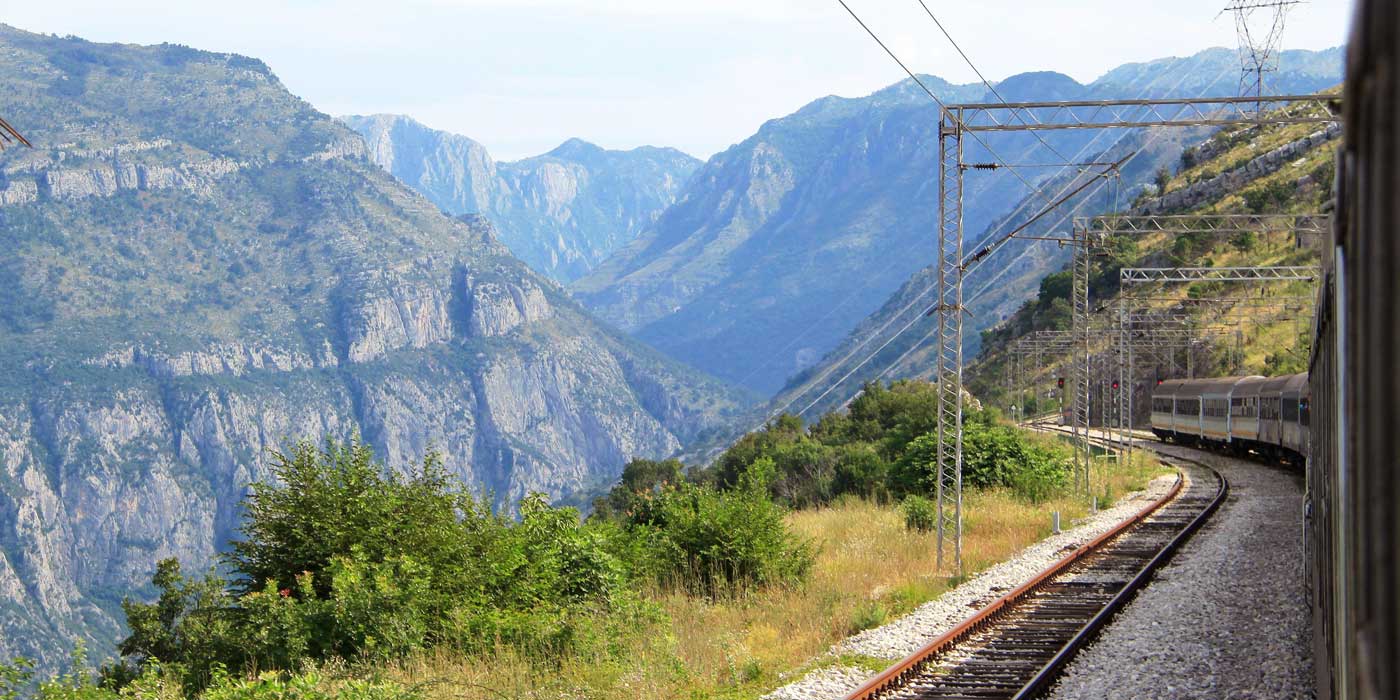Belgrade to Bar Railway
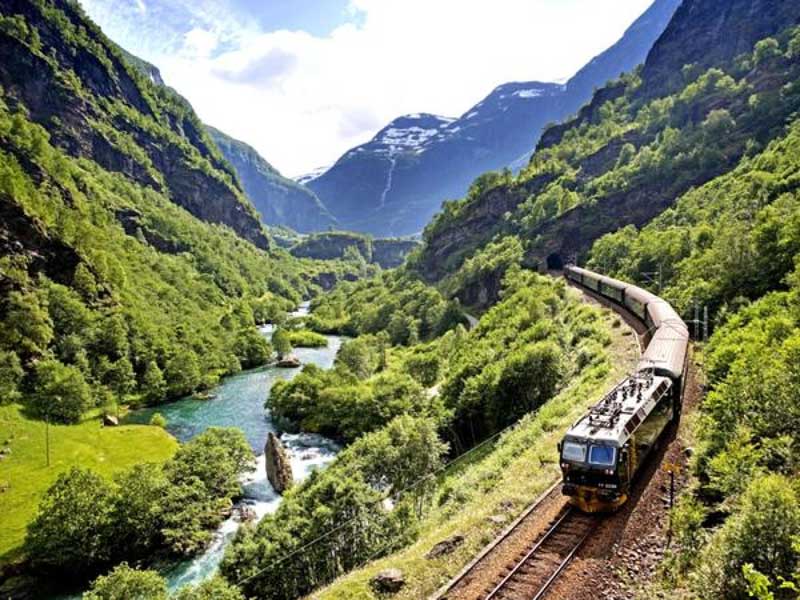
The Belgrade-Bar railway is a standard gauge railway, 476 km long between the Serbian capital of Belgrade and the Adriatic town of Bar in Montenegro. Of this length, 301 km of the railway goes through Serbia, and 175 km through Montenegro. It is electrified along the entire corridor, it passes through 254 tunnels, and over 435 bridges. The longest tunnels are "Sozina" 6.17 km and "Zlatibor" 6.139 km. The biggest and the best known bridge is Mala Rijeka viaduct, 498 m long and 198 m above ground level.
The highest point of the railway is at 1,032 m (3,386 ft) AMSL, at the town of Kolasin. The railway descends to 40m AMSL at Podgorica in a relatively short distance, thus the gradient of 25 percent on this section. A small 9 km section of the railway actually passes through Bosnia and Herzegovina, near the town of Strpci, but the trains do not stop there. The best mountain scenery is within Montenegro, between Bijelo Polje and Bar.
When built, it took a train approximately seven hours to complete the trip from Belgrade to Bar. Today it takes 11 hours, due to speed restrictions, as the railway cannot safely sustain the projected speeds without being thoroughly rebuilt.
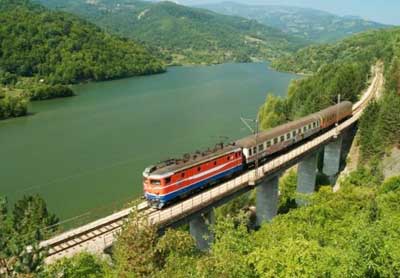
The decision to build the railway connection between Belgrade and Bar was made in 1952, as a national project of the SFRY. However, the construction was passed to the constituent Republics, SR Serbia and SR Montenegro, to build on their own. The construction works were concluded on 27 November 1975, by joining the railway tracks south of Kolasin. The line was opened to much fanfare in 1976 by the Yugoslavian ruler Tito, whose private Blue Train once rumbled regularly along the route. Electrification was completed at the end of 1977.
Maintenance of the Belgrade-Bar railway suffered from chronic underfunding during the 1990s, which has resulted in the railway deteriorating and becoming unsafe. This culminated in the Bioce derailment, when a passenger train derailed, causing the deaths of 47 passengers. As a result, efforts are being made to thoroughly reconstruct the railway.
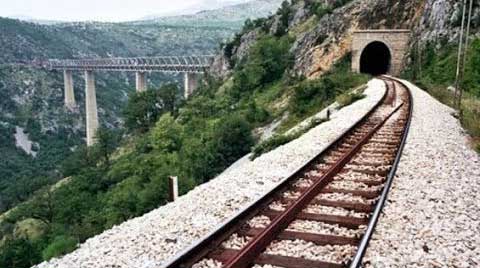
The Serbian part of the railway was targeted several times by NATO during its bombing campaign in 1999, seriously damaging portions of the railway. Also the small section that passes through Bosnia and Herzegovina was blown up by SFOR ground forces. All of this damage was later repaired.
Riding the Belgrade to Bar Railway
This spectacular scenic railway is one of Europe's most stunning train journeys. The service takes 10 hours, and utilises carriages with old-style, six-berth compartments, so it is very much a non-frills service, but that brings an added bonus - low cost tickets to travel on it. Though Serbia is getting more accustomed to receiving foreign tourists these days, this is very much a local train so the use of signage in English is limited, and as the majoity of fellow passengers don't speak it, any conversation you have with them will be in broken English at best and sign language at worst.
The line's best mountain scenery is within Montenegro, between Bijelo Polje and Bar.
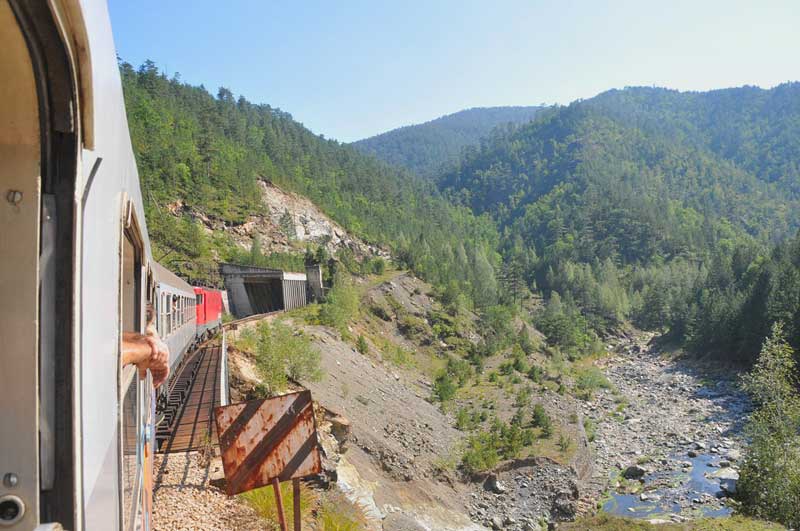
The service has a night and day trin. The daytime train is 2nd class only usually with cafe-bar. The sleeper train has 6-berth couchettes, 4-berth couchettes and 1, 2 and 3 bed sleepers with washbasin. If travelling at night, the southbound sleeper train Lovcen is a good train to take as it'll be light in the morning. The southbound Tara covers the best sections in darkness during winter. The northbound day train is best for scenery all year round, the northbound sleeper train is also good in summer when it's light.
You can book a southbound train from Belgrade to Montenegro either at the station. The northbound train can easily be booked at the station in Bar or Podgorica, but cannot be booked online. If passing through Belgrade southbound, you can also book there.
Destinations
Belgrade
Belgrade is the capital of the southeast European country of Serbia. Its most significant landmark is the Beogradska Tvriava, an imposing fortress at the confluence of the Danube and the Sava rivers. The fort is a testament to the city's strategic importance to the Roman, Byzantine, Ottoman, Serbian and Austrian empires, and it's now the site of several museums as well as Kalemegdan, a vast park. Belgrade is located at the confluence of the Sava and Danube rivers, where the Pannonian Plain meets the Balkans. The urban area of the City of Belgrade has a population of 1.23 million, while over 1.68 million people live within its administrative limits.
Valjevo
Valjevo is a city and the administrative centre of the Kolubara District in western Serbia. Since times of old, life in Valjevo thrives in two city quarters, of which one keeps the spirit of Orient, and the other of the 19th century Europe, all the while their authenticity serves as an ambient for many cultural events. Valjevo is 100km from Belgrade.
Uzice
Uzice, in Serbia's south west, is reached four hours into the journey from Belgrade. The town was the first in Yugoslavia to be liberated from the Nazis in the Second World War. From Uzice it is as short bus ride from Zlatibor, a resort town in the Dinaric Alps. Uzice is a city and the administrative center of the Zlatibor District. Uzice has a very attractive setting, in a limestone gorge, with red-roofed houses spreading up the hillsides.
Bijelo Polje
The train crosses from Serbia to Montenegro with a Serbian passport check at Prijepolje then a Montenegrin passport check at Bijelo Polje, a town in northeastern Montenegro on the Lim River. It has an urban population of 15,400, and is the administrative, economic, cultural and educational centre of northern Montenegro. It is a picturesque city surrounded by rich pastures, wells and large forests.
Kolasin
After passing into Montenegro, the scenery becomes truly spectacular. The summit is reached soon after Kolasin, at over 1,000m above sea level before the line descends steeply towards Podgorica. Founded by Turks in 17th century, the small city of Kolasin is one of the must visit places in Montenegro. Located at 954 m of altitude, it offers excellent vacation as in winter as well as summer. Because of its altitude and favourable climate, Kolasin is considered a spa town.
Podgorica
Before reaching Podgorica, the capital of Montenegro, the train passes through some dramatic topography. The tunnels and bridges come thick and fast as the line winds its way down the Balkans. Podgorica - which from 1946 until 1992 was known as Titograd - sits just over an hour's ride from the port town of Bar. After Podgorica, the train trundling past Lake Skadar before heading into the olive belts of the coastal hills. For the last few miles it traces the Adriatic.
Podgorica is Montenegro's official commercial and cultural centre. The name originates in 1326 and it is built amongst five rivers, the Zeta, Moraca, Ribnica, Cijevna and Sitnica. Most of the city was destroyed during World War II, so Podgorica is relatively new, with plenty of modern buildings and green spaces as well as parks. Podgorica hosts a number of cultural events and there are many theatres, such as Crnogorsko Narodno, Gradsko and Dodest.
Bar
Although it is a port town on the Adriatic Sea, Bar is amazingly clean and has many developed green areas. Around it there are many tourist attractions. The old town of Bar, Haj Nehaj Fortress, with the remnants from the 15 th century fortress and the castle of King Nikola, represent the historic and cultural monuments of this town.
There is an Old Olive Tree that is more than 2000 years old and Skadar lake, with one of the biggest habitats of birds, as well as a large number of monasteries and churches for the visitors who enjoy this type of tourism.


